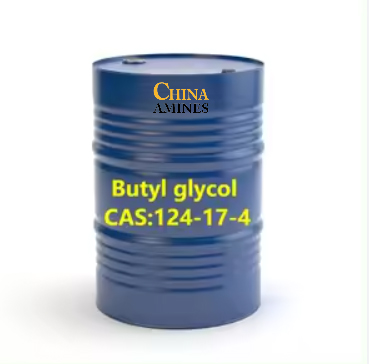1. Chemical Structure and Properties
Molecular Formula: C₆H₁₂O₃
Structural Formula:
CH₃COO–CH₂CH₂–O–CH₂CH₂CH₂CH₃
A glycolic acid ester formed by the esterification of glycolic acid with n-butanol.
Physical Properties:
Appearance: Clear, colorless liquid with a faint fruity odor.
Boiling Point: 180–185°C; Density: 1.02–1.04 g/cm³; Vapor Pressure: <0.1 mmHg at 25°C.
Solubility: Miscible with alcohols, ethers, and esters; slightly soluble in water (2% w/w at 20°C).
Chemical Properties:
Hydrolysis Stability: Hydrolyzes slowly in water under acidic or alkaline conditions to glycolic acid and butanol.
Thermal Stability: Decomposes above 200°C, releasing CO₂ and hydrocarbons.
Flammability: Combustible (flash point: 75°C; autoignition temperature: 320°C).
2. Industrial Applications
Coatings & Inks:
Solvent & Plasticizer: Enhances flexibility and adhesion in waterborne paints and printing inks.
Personal Care:
Emollient & Humectant: Used in skincare products (e.g., lotions, creams) for moisture retention and texture enhancement.
Cleaning Products:
Degreaser: Effective in removing oils and greases from industrial equipment.
Chemical Synthesis:
Intermediate: Produces biodegradable polymers and specialty esters for lubricants.
3. Safety and Toxicology
Acute Exposure:
Inhalation: Irritates respiratory tract (TLV-TWA: 10 ppm); dizziness and headaches at high concentrations.
Skin Contact: Causes mild irritation (rabbit skin LD₅₀: >5,000 mg/kg); negligible systemic absorption.
Ingestion: Low toxicity (oral LD₅₀ rat: >5,000 mg/kg); gastrointestinal discomfort.
Chronic Effects:
Reproductive Toxicity: No teratogenicity observed in OECD 414 studies.
Organ Toxicity: Limited evidence of liver or kidney damage in subchronic rodent studies.
Protection Measures:
PPE: Nitrile gloves, safety goggles, and general ventilation.
Storage: Store in HDPE containers away from oxidizers and heat sources.
4. Environmental and Regulatory Compliance
Environmental Impact:
Biodegradability: Moderate (OECD 301F: 50–70% degradation in 28 days).
Aquatic Toxicity: LC₅₀ (fish, 96h): >100 mg/L; EC₅₀ (daphnia, 48h): >50 mg/L.
Bioaccumulation: Low (log Kow: 1.2).
Regulatory Frameworks:
EU:
REACH: Registered with no SVHC listing; CLP classification Not Hazardous.
USA:
EPA: TSCA-listed; exempt from VOC status under 40 CFR 51.100(s)(1).
China:
GB 13690-2009: Classified as General Chemical (non-hazardous).
Waste Management:
Incinerate in approved facilities; landfill disposal permitted for neutralized residues.
5. Case Studies and Application Insights
Case 1: Eco-Friendly Coatings (Sherwin-Williams, 2023):
Challenge: Reduce VOC emissions in architectural paints without compromising performance.
Solution: Butyl glycolate replaced 15% of petroleum-based solvents.
Result: Achieved 20% lower VOC emissions (ASTM D6886) and maintained scrub resistance (ASTM D2486).
Case 2: Biodegradable Polymer Production (BASF, 2022):
Process: Used butyl glycolate as a monomer in biodegradable polyester synthesis.
Impact: Produced polymers with 90% biodegradability (ISO 14855) and reduced carbon footprint.
Comparative Analysis:
Butyl Glycolate vs. Ethyl Glycolate:
Pros: Lower volatility; better compatibility with hydrophobic resins.
Cons: Higher cost and slower hydrolysis rate.
Butyl Glycolate vs. Butyl Acetate:
Pros: Lower toxicity; superior biodegradability.
Cons: Lower solvency for non-polar compounds.
Specifications:
Filler monobutyl ether is an organic compound with the chemical formula C6H14O2. It is a colorless and transparent liquid, containing oil, water, acetone, benzene, ether, methanol, four-carbon organic solvents and minerals. It is mainly used in paints, especially nitro spray paints and quick-drying paints. High boiling point solvent for paints, varnishes, ceramic nitrates and paint removers. It can also be used as inactive dispersants for glues, metal detergents, paint removers, fiber wetting agents, pesticide dispersants, pharmaceutical extractants, and resin plasticizers.


